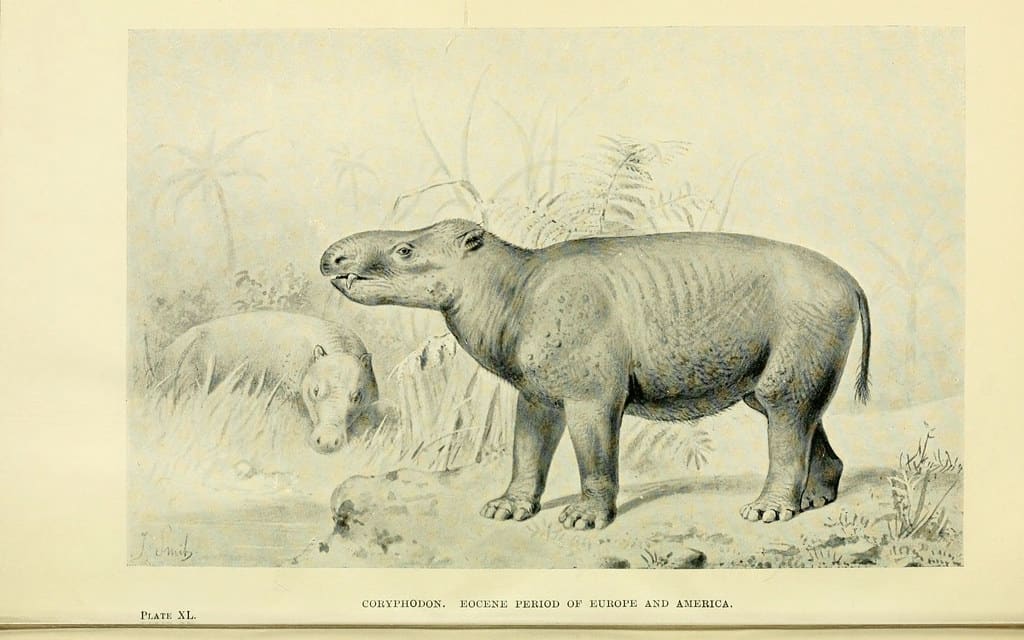About 63 to 52 years ago, during the late Paleocene to middle Eocene Period, a large mammal known as the Coryphodon roamed the earth. These creatures had a similar appearance to a modern-day rhinoceros. They were one of the first giant genera of mammals that appeared after dinosaurs. The Coryphodon likely had an intimidating appearance, with its oddly shaped head and bulky body. This animal had one of the smallest brain-to-body ratios at the time. However, although their brains were small, they were probably intelligent, according to what we know about similar animals today. Join us, as we learn about this huge mammal with a small brain!
The Largest Land Animal at the Time

Coryphodon was a large, heavy mammal that was similar to a hippo.
©Charles R. Knight / public domain – License
The largest species in the Coryphodon genus reached 8.2 feet in length with a height of 3.3 feet. They weighed up to a ton, making them extremely large mammals at the time. Their size is comparable to an elephant, but their body structure resembles a hippo or a rhino.
Coryphodons were the world’s first-ever group of large browsing animals. They are believed to be one of the largest land animals known as pantodonts at the time of their existence.
However, not all species of the Coryphodon grew to such impressive sizes. Most species did not grow to be as large as the Coryphodon proterus, the largest of the four Coryphodon species.
The C. proterus and C. lobatus grew the largest. While the C. eocaenus was the smallest at 750 pounds, the C. radians weighed 1,500 pounds.
An Odd Appearance
Coryphodon was a heavy creature, and their movements were slow and sluggish. The Coryphodon’s short and stumpy limbs didn’t allow them to move with speed. Their barrel-shaped bodies were built for slow, grazing behaviors. They had strong and prominent neck muscles and tusks that they likely used to uproot plants to eat. Broad feet helped stabilize their heavy weight. Their head had no horns or occipital region and their strong limbs helped to support the Coryphodon’s heavy weight.
They didn’t have much to protect them from predators. Their tusks were for eating, and their teeth weren’t made for hunting.
Small Brain to Body Ratio

The Coryphodon had a very small brain with weighed only around 3.2 ounces, despite its large size.
©Jonathan Chen/Wikimedia Commons – License
Brain size usually increases in size as the animal grows, especially if the animal is very large. However, the Coryphodon’s brain didn’t develop past a certain size. Comparing brain to body size is known as brain to body mass ratio, and it was once used to indicate an animal’s level of intelligence. However, scientists have discovered that brain size is not a direct indication of intelligence.
Coryphodon had a brain that scientists believe only weighed around 3.2 ounces. For such a large animal, you would expect its brain to be a bit larger. For reference, a human’s brain weighs around the same, despite our bodies being much smaller.
So, how could such a large animal have such a small brain? Though odd, this size contrast is not uncommon. The modern-day elephant has a comparatively small brain-to-body size.
Since elephants are extremely intelligent mammals, it is unlikely that the size of the brain has anything to do with an animal’s intelligence.
Some of Earth’s largest animals have a small brain-to-body ratio, but they were not dumb. Rather than brain size, it is the neurons that make you smart. Certain neurons in the brain are responsible for cognitive function and abilities.
It has been found that large animals like the elephant have von Economo neurons in their frontal cortex. This is why these large animals with such a small brain-to-body ratio are so intelligent. The same theory can be applied to the Coryphodon.
Why Do Some Animals Have a Small Brain?

Although Coryphodon had a small brain, it may have been smart, as brain size doesn’t reflect intelligence.
©Biodiversity Heritage Library/Flickr – License
When it comes to brains, structure is more important than size, and this is true for many intelligent animals. Since a human has a folded brain with a complicated cortex and von Economo neurons, we are seen as one of the most intelligent and mentally superior “animals” on earth.
The brain-to-body ratio for most mammals is around 1:180, and some of the most intelligent animals have the highest brain-to-body ratio. However, it is rather the volume of the cerebral cortex for cognitive processing that matters, along with certain neurons.
It is unclear why some animals have a larger brain-to-body mass ratio than others, and it could be dependent on how the animal has evolved throughout millions of years.
Does a Small Brain Make You Dumb?
It is widely thought that any animal with a small brain is automatically dumb. However, this can’t be true, as many of Earth’s most intelligent animals have a low brain-to-body ratio. Even though the Coryphodon’s brain was not in proportion to its body mass, these animals were likely fairly intelligent. If they were anything like the elephant, they were probably quite clever at the time.
Scientists cannot be sure of the Coryphodon’s specific cognitive abilities, since these creatures went extinct millions of years ago. We can only go off modern research, which states that the size of your brain does not prove your intelligence.
The photo featured at the top of this post is © Charles R. Knight / public domain – License / Original
Sources
- Netral news, Available here: https://netral.news/en/5-animals-with-small-brain-capacity-compared-to-their-bodies.html
- Wikipedia , Available here: https://en.wikipedia.org/wiki/Brain%E2%80%93body_mass_ratio
- Scientific America , Available here: https://www.scientificamerican.com/article/does-brain-size-matter1/
Thank you for reading! Have some feedback for us? Contact the AZ Animals editorial team.






